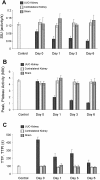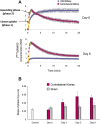Assessment of renal function in mice with unilateral ureteral obstruction using 99mTc-MAG3 dynamic scintigraphy
- PMID: 23228112
- PMCID: PMC3542003
- DOI: 10.1186/1471-2369-13-168
Assessment of renal function in mice with unilateral ureteral obstruction using 99mTc-MAG3 dynamic scintigraphy
Abstract
Background: Renal scintigraphy using 99mTc-mercaptoacetyltriglycine (99mTc-MAG3) is widely used for the assessment of renal function in humans. However, the application of this method to animal models of renal disease is currently limited, especially in rodents. Here, we have applied 99mTc-MAG3 renal scintigraphy to a mouse model of unilateral ureteral obstruction (UUO) and evaluated its utility in studying obstructive renal disease.
Methods: UUO mice were generated by complete ligation of the left ureter. Sham-operated mice were used as a control. Renal function was investigated on days 0, 1, 3, and 6 post-surgery using dynamic planar imaging of 99mTc-MAG3 activity following retro-orbital injection. Time-activity curves (TACs) were produced for individual kidneys and renal function was assessed by 1) the slope of initial 99mTc-MAG3 uptake (SIU), which is related to renal perfusion; 2) peak activity; and 3) the time-to-peak (TTP). The parameters of tubular excretion were not evaluated in this study as 99mTc-MAG3 is not excreted from UUO kidneys.
Results: Compared to sham-operated mice, SIU was remarkably (>60%) reduced in UUO kidneys at day 1 post surgery and the TACs plateaued, indicating that 99mTc-MAG3 is not excreted in these kidneys. The plateau activity in UUO kidneys was relatively low (~40% of sham kidney's peak activity) as early as day1 post surgery, demonstrating that uptake of 99mTc-MAG3 is rapidly reduced in UUO kidneys. The time to plateau in UUO kidneys exceeded 200 sec, suggesting that 99mTc-MAG3 is slowly up-taken in these kidneys. These changes advanced as the disease progressed. SIU, peak activity and TTPs were minimally changed in contra-lateral kidneys during the study period.
Conclusions: Our data demonstrate that renal uptake of 99mTc-MAG3 is remarkably and rapidly reduced in UUO kidneys, while the changes are minimal in contra-lateral kidneys. The parametric analysis of TACs suggested that renal perfusion as well as tubular uptake is reduced in UUO kidneys. This imaging technique should allow non-invasive assessments of UUO renal injury and enable a more rapid interrogation of novel therapeutic agents and protocols.
Figures








References
-
- Fritzberg AR, Kasina S, Eshima D, Johnson DL. Synthesis and biological evaluation of technetium-99m MAG3 as a hippuran replacement. J Nucl Med. 1986;27(1):111–116. - PubMed
-
- Gates GF. Filtration fraction and its implications for radionuclide renography using diethylenetriaminepentaacetic acid and mercaptoacetyltriglycine. Clin Nucl Med. 2004;29(4):231–237. doi: 10.1097/01.rlu.0000117998.67737.ae. - DOI - PubMed
Publication types
MeSH terms
Substances
Grants and funding
LinkOut - more resources
Full Text Sources
Other Literature Sources

